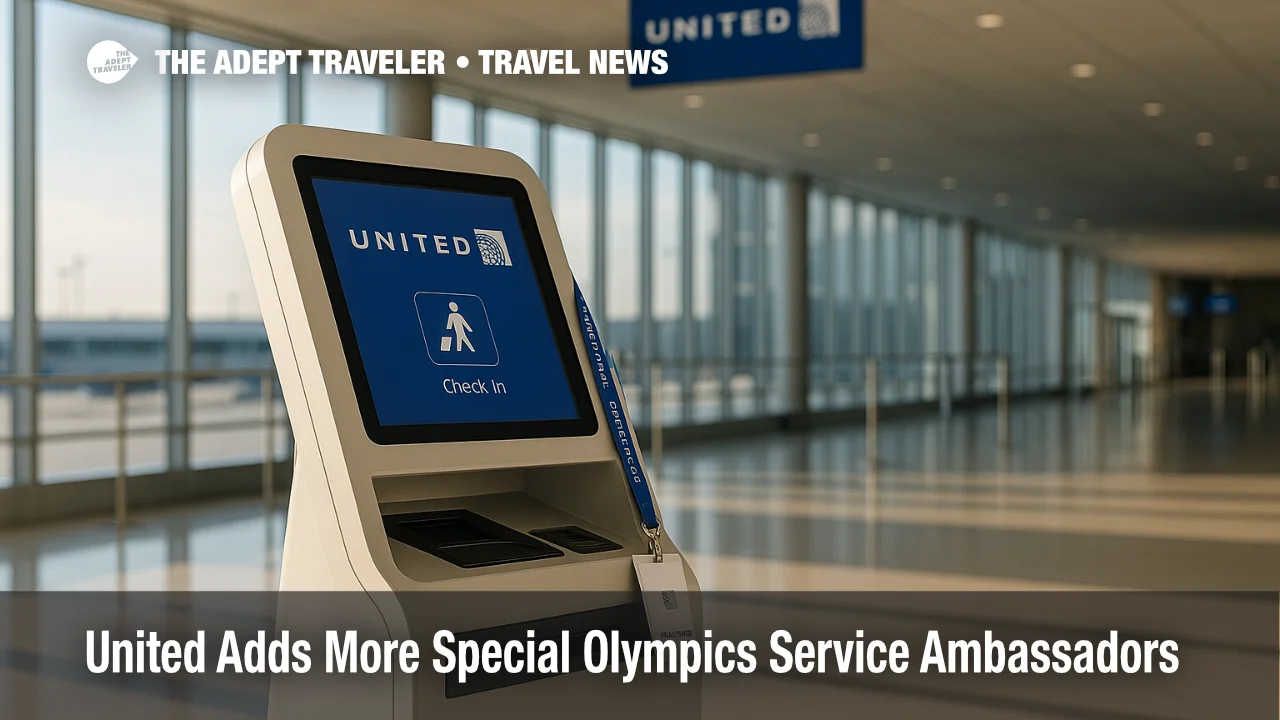United Adds More Special Olympics Service Ambassadors

United Airlines will welcome 10 new Special Olympics Service Ambassadors this fall, expanding the award-winning program to its hubs in Los Angeles, San Francisco, and Newark. Once on board, the ambassadors-who are Special Olympics athletes-will guide travelers at check-in, bag drop, and security, then assist in the concourse using United's digital service tools. The expansion boosts the roster to 28 ambassadors across all seven U.S. hubs and reinforces United's long-standing partnership with Special Olympics. NFL legend Jerry Rice joined a recruitment "boot camp" at San Francisco International Airport (SFO), underscoring the airline's commitment to inclusive,
customer-centric service.
Key Points
- United will add 10 Special Olympics Service Ambassadors in LAX, SFO, and EWR.
- Total ambassador team will reach 28 across seven domestic hubs.
- Ambassadors receive part-time roles with full employee benefits.
- Jerry Rice helped train and recruit candidates at SFO.
- Why it matters: The program sets a new industry benchmark for disability inclusion in front-line airport jobs.
Program Snapshot
Launched at O'Hare International Airport (ORD) in 2019, the Special Olympics Service Ambassador (SOSA) program gives athletes paid, benefits-eligible roles that focus on way-finding and customer assistance. Ambassadors greet travelers in terminal lobbies, point guests to kiosks, bag counters, and TSA lines, then provide post-security guidance for gates, amenities, and digital self-service options. United offers tailored training, mentors, and schedule flexibility, ensuring ambassadors can balance work with athletic commitments. The model has proved so successful that several ambassadors have celebrated five-year anniversaries, citing teamwork, communication skills, and traveler gratitude as daily highlights.
Background
United's relationship with Special Olympics spans decades of sponsorships, plane-pull fund-raisers, and Miles on a Mission donation drives. In 2019, the carrier formalized that connection by creating SOSA jobs to coincide with National Disability Employment Awareness Month. Early pilots in Chicago quickly demonstrated faster lobby queuing and higher customer-satisfaction scores. Houston (IAH), Denver (DEN), and Washington Dulles (IAD) adopted the model next, giving the program a geographic spread that mirrors the airline's network. Internally, SOSA hiring aligns with United's broader accessibility push-braille seat-row markers, improved wheelchair handling, and a wheelchair-friendly flight-search tool rolled out last year-each designed to remove friction for travelers who have disabilities and to foster a culture of universal welcome.
Latest Developments
The July 18 announcement signals the next growth phase for SOSA.
Recruitment in Coastal Hubs
Los Angeles International Airport (LAX), San Francisco International Airport (SFO), and Newark Liberty International Airport (EWR) will each onboard ambassadors before the holiday rush. Local Special Olympics chapters are already identifying candidates skilled in interpersonal communication and mobile-app navigation.
NFL Star Boosts Visibility
Hall-of-Famer Jerry Rice donned a United vest at SFO, shadowing current ambassadors through lobby meet-and-greet drills and self-service kiosk demos. His participation generated both social-media buzz and local news coverage, amplifying the hiring call to athletes nationwide.
Roles, Pay, and Benefits
New hires will work up to 25 hours per week, earning airline medical coverage, flight privileges, and access to United's employee resource groups. Duties include assisting travelers with United's Agent on Demand video kiosks and providing real-time gate-change updates-a skill set that dovetails with many ambassadors' competitive sports training in teamwork and situational awareness.
Analysis
United's decision to scale SOSA demonstrates how inclusive hiring can simultaneously strengthen brand reputation and operational performance. Travelers who require extra guidance-families, infrequent flyers, older adults-often find the ambassadors more approachable than standard uniformed staff, reducing lobby confusion and missed-flight incidents. For the airline, that translates into shorter lines, fewer rebookings, and higher customer-satisfaction metrics. The program also aligns with shifting consumer expectations: a recent Open Doors Organization survey found that U.S. travelers with disabilities spent more than $11 billion on air travel last year, up 40 percent from pre-pandemic levels. By foregrounding accessibility in visible frontline roles, United captures goodwill from this growing demographic while reinforcing its broader accessibility initiatives-such as braille placards and wheelchair-fit tools-that differentiate it from legacy competitors. Finally, SOSA offers a replicable template for other carriers looking to integrate inclusive employment without extensive retrofits, proving that soft-skill service roles can be both meaningful and operationally valuable.
Final Thoughts
Travelers passing through United's busiest hubs will soon be greeted by even more Special Olympics athletes, adding warmth, efficiency, and authenticity to the airport experience. The expansion highlights how inclusive hiring can enrich both workplace culture and customer journeys. For travelers seeking additional advice on navigating airports with mobility or sensory needs, our primer on Accessible Travel offers practical tips and advisor-ready planning insights. With visible ambassadors and behind-the-scenes upgrades, United is turning accessibility into an everyday reality-one welcome smile at a time, carried forward by the Special Olympics Service Ambassador program.
